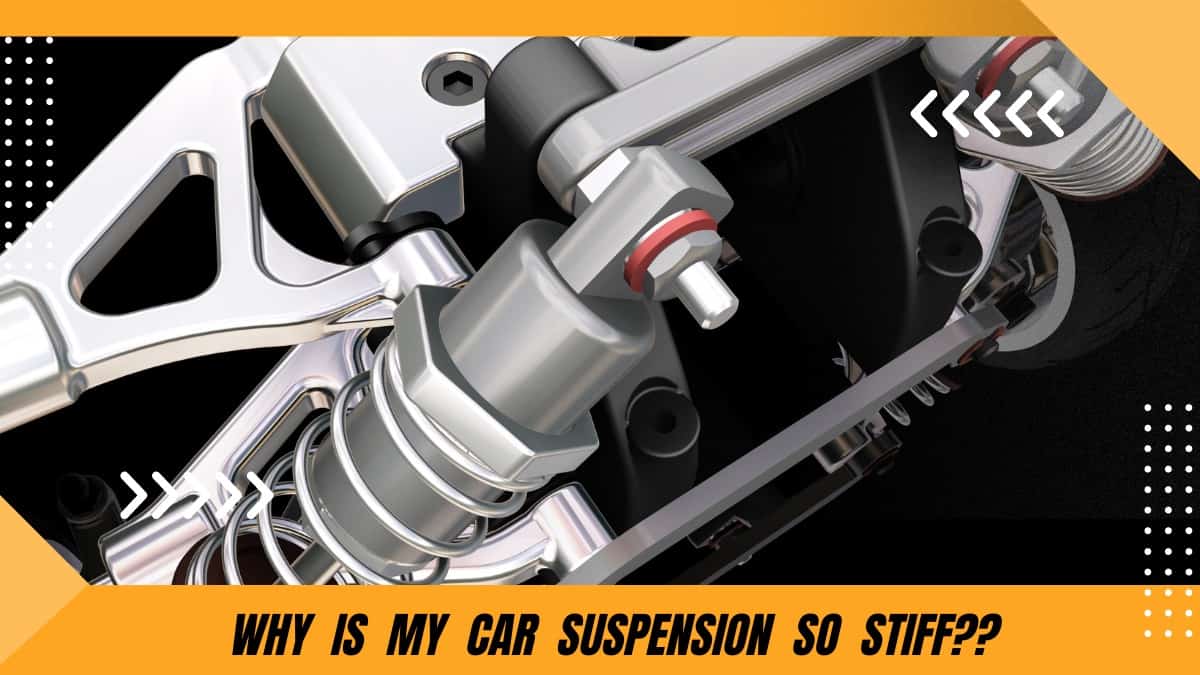
If your car suspension is causing some issues and you are wondering Why Is My Car Suspension So Stiff? Then read this article.
Suspension is one of the most essential component of a car. It ensures that it smoothens up the whole passenger ride and manages your car so it is steady. The primary function of a car suspension is to increase friction in the tires so as to provide amazing steering stability and fantastic handling of the car.
The component of a tyre, tyre air, spring, shock absorber, and linkages that attach an automobile to its tyres and permit them to move with one another is known as suspension. Suspension systems accommodate both road holding and good rides, which are incompatible. Suspension tuning is all about striking the proper balance. The suspension must maintain as much contact with the ground as possible because every road and ground force operating on the automobile will be transmitted through the touch patches of the tyres.
The suspension also defends the vehicle from damage, wear and tear, and any cargo or luggage. A car’s rear and front suspension can be customized. Your automobile will bounce up and down when you drive quickly or strike bumps. However, the firmer your break, the less it will reflect (which will give you a smoother ride). If you drive a lighter vehicle, the suspension could bounce more, giving the impression that it has a firmer suspension. It is because “stiffness” is assessed by the amount of movement the vehicle provides, i.e., the amount of chassis jiggles.
In the below paragraphs, let us examine how can we soften a stiff suspension.
Changing the spring is easy to tighten or soften your car’s suspension setup. It is not an easy task in some countries because only some automobiles have postsales and more robust spring rates to offer. However, several foreign rally versions have sporty suspension springs that may be purchased and fitted. The same may be done by buying springs with greater flex. If you think you are unable to do it by yourself then you can also contact a auto suspension shop to do it for you.
If you want a soft suspension system but can’t locate stronger springs that fit your automobile, you can install pads under the spring where it meets the base plate. It will help raise the car’s ground clearance slightly and smoothen the ride.
Anti-roll bars or stabilizer bars aid in managing a car’s movement by regulating its behaviour. Most automobiles now include anti-roll and sway bars to control roll motion and slightly tighten the ride. Sway bars can be installed on cars that do not have them to pull the ride. If you desire greater flexibility and a smoother ride, you may eliminate the sway bar, which results in a softer ride but significantly impacts handling.
While too stiff a suspension may result in flying airborne when striking a bump, it may also fail to contact the road quickly enough if there is a dip in the street. Consider an automobile with an incredibly stiff spring in the front left tyre or a nice and soft spring in the front right tyre, approaching a 20-millimetre indent ahead where the road lowers.
Which tyre will make first contact with the road? You may expect the greater spring rate to react faster, but the lower spring constant will make contact with the ground soon, allowing for more grip. Again, picturing an endlessly high-rate spring (a fixed suspension), you’d rely on gravity to drop the automobile into the hole. With a low spring rate, the overall force forcing the tyre down remains higher for a more extended time in proportion to the total travel, causing the tyre to make contact with the floor much sooner.
When it comes to cracks, bumps, and surface imperfections on the road, a smoother suspension will provide a more outstanding mechanical grip since it will perform a more effective job of keeping the tyres on the ground than a rigid suspension. Further, It depends on the type of ride you intend to take. You must modify the suspension for everyday touring and track day rides.
Your sports vehicle and the daily commuter vehicle will have distinct needs. You may select a different suspension for a sporty bike or even a heavy-output car. A smoother suspension will work better if your vehicle is built for performance and comfort. Choose mild breaks if you mostly drive on countryside highways and roads with the gentler ground.
When it comes to the best ride quality or handling accuracy, a car’s suspension stiffness is a significant factor in determining how the automobile feels or behaves on the road. Every suspension characteristic, such as tyre rate, dampening, objective and subjective ride, and handling, is centred on suspension stiffness. Suspension stiffness refers to the spring present in an automobile’s wheel suspension. It refers to the spring rate, which is determined by the strength exerted by the spring proportionate to its change in length when compressed or stretched.
Vehicles that carry big loads are often equipped with more robust springs to accommodate the increased weight. For a larger car, a softer spring would squeeze the coil far too much, causing the suspension to “bottom out.” A stiffer spring is installed on a heavier automobile, and a soft spring is installed on a smaller vehicle. So, in general, the stiffness intended for a specific automotive suspension would’ve been proportional to the vehicle’s weight that the brake must sustain at a specified height.
Yes, you can make your car suspension softer. There are many ways to do that. Let’s discuss this in a bit more detail.
Your car’s suspension supports the load of the items carried upon the chassis. The suspension system doesn’t require the components located beneath the chassis, including the tyres, alloys, and the pieces that keep the system set up. The total weight of the items that aren’t maintained by the suspensions system is referred to as unsprung weight.
Replacing the suspension system with a softer one produces the best effects when it comes to making your vehicle’s riding experience more smooth. Swapping firmness shock absorbers with comfort shock absorbers is a simple technique to soften your suspension. You may also add Air Suspension depending on your car’s suspension system.
Car tyres come in a variety of sizes and styles. Low-profile tyres look nice and help to lower the height of your ride. However, installing them on your vehicle alters the handling and comfort of your ride. The limited area provided by low-profile tyres carries less air, making the ride seem rigid. Always consult a professional car mechanic and choose the correct tire size. You can also have a look at the car manual for the same.
Irrespective of the design, steel springs are exceedingly robust and resilient. They usually do not soften with time. They can, however, be twisted or fractured, which is due to vehicle abuse. Springs in ancient automobiles can deteriorate and droop over time because of the steady weight of the vehicle. To avoid this, auto retailers often clamp up the auxiliary springs.
Some rubber bushings get tougher with age rather than softer. Shock absorbers, which are gas and oil-damped devices, wear out and result in a smoother, less responsive ride.
A suspension is one of the core parts of a car. Please visit a mechanic if you find any problems with your vehicle. The reason why your suspension system is so stiff is due to the shock absorber. The improved suspension reduces the ride comfort of most automobiles. Some owners adjust their suspension to make their vehicles sit lower and “look sportier.” Lowering the rest reduces the overall length the wheel may travel while increasing ride firmness.
Furthermore, replacing the dampers with faster (stiffer) ones would degrade the overall performance of a car. You might be able to handle the automobile well, but only on flat surfaces, such as a racetrack. The automobile would become uncontrollable on any other road, particularly uneven tracks. Changing the dampers will not enhance the ride. The springs may also need to be replaced. Any workshop equipped with a yard hoist may determine which suspension items are not original. It is better to return an automobile only three years old to the dealer. Finally, while some enhanced suspensions are adjustable, a lot is needed to lessen ride roughness appreciably.
Fill out the contact form and we will call you as soon as possible to discuss service, repairs or any general enquiries.
